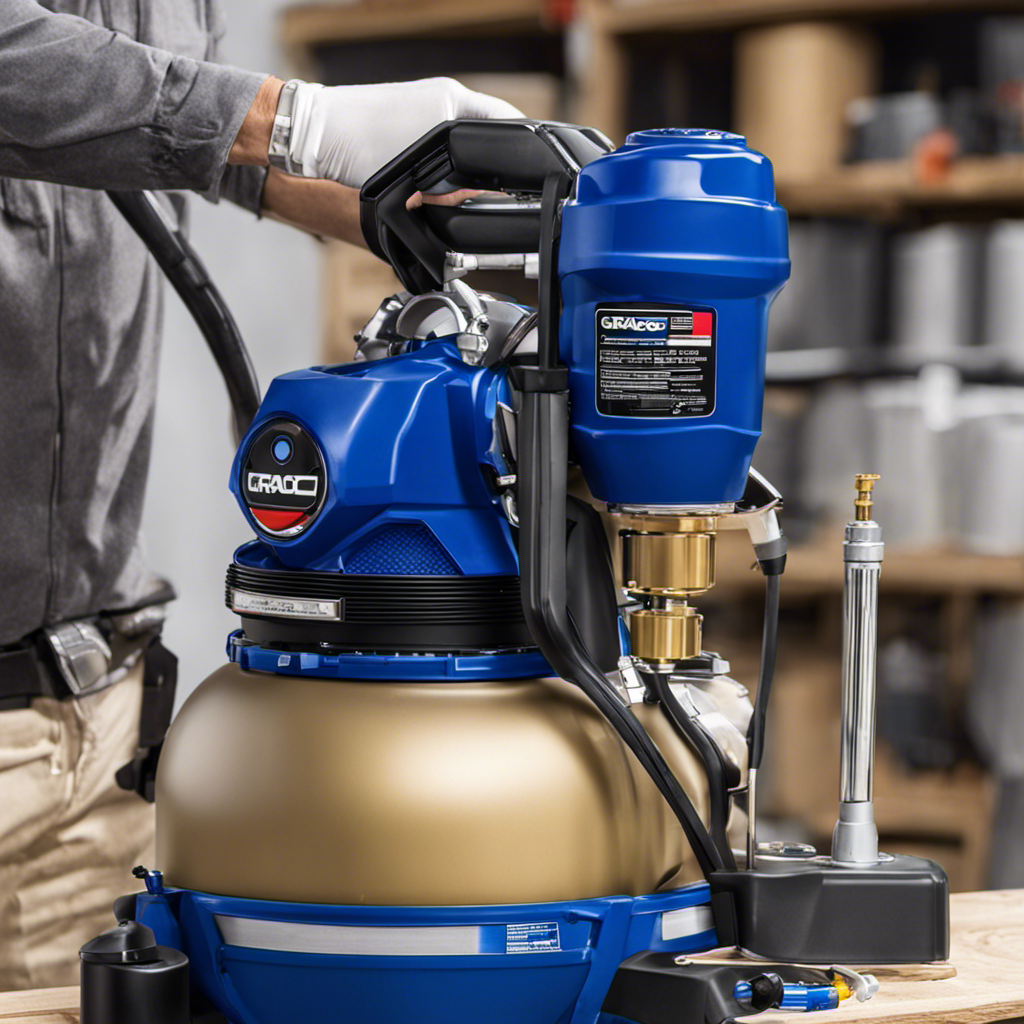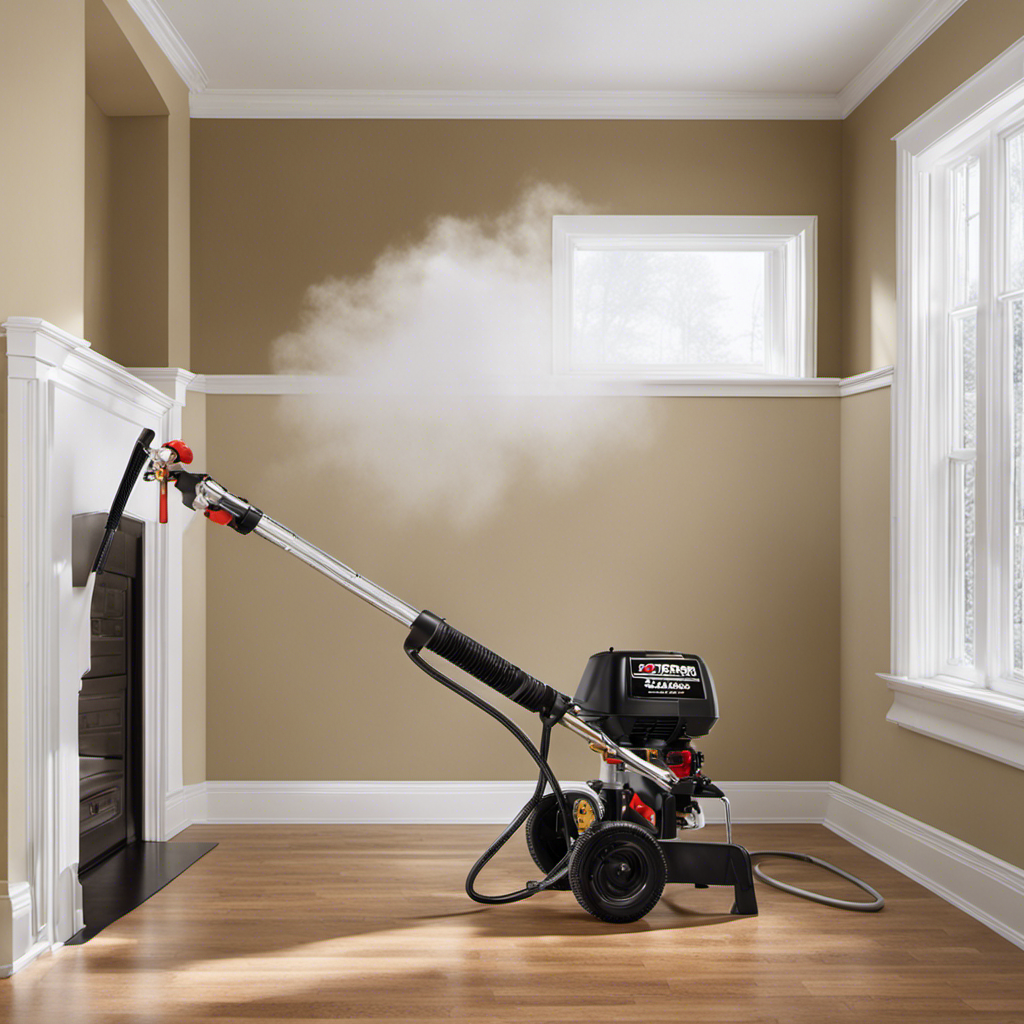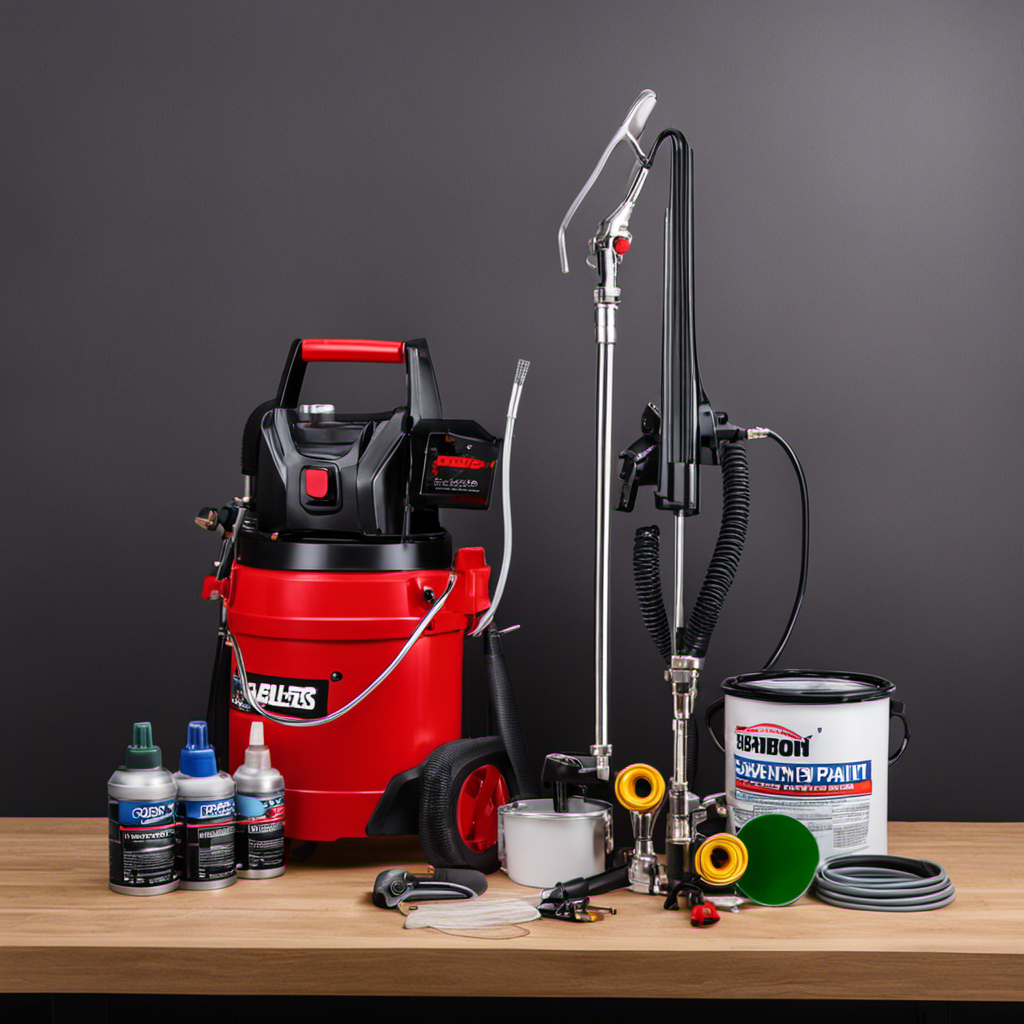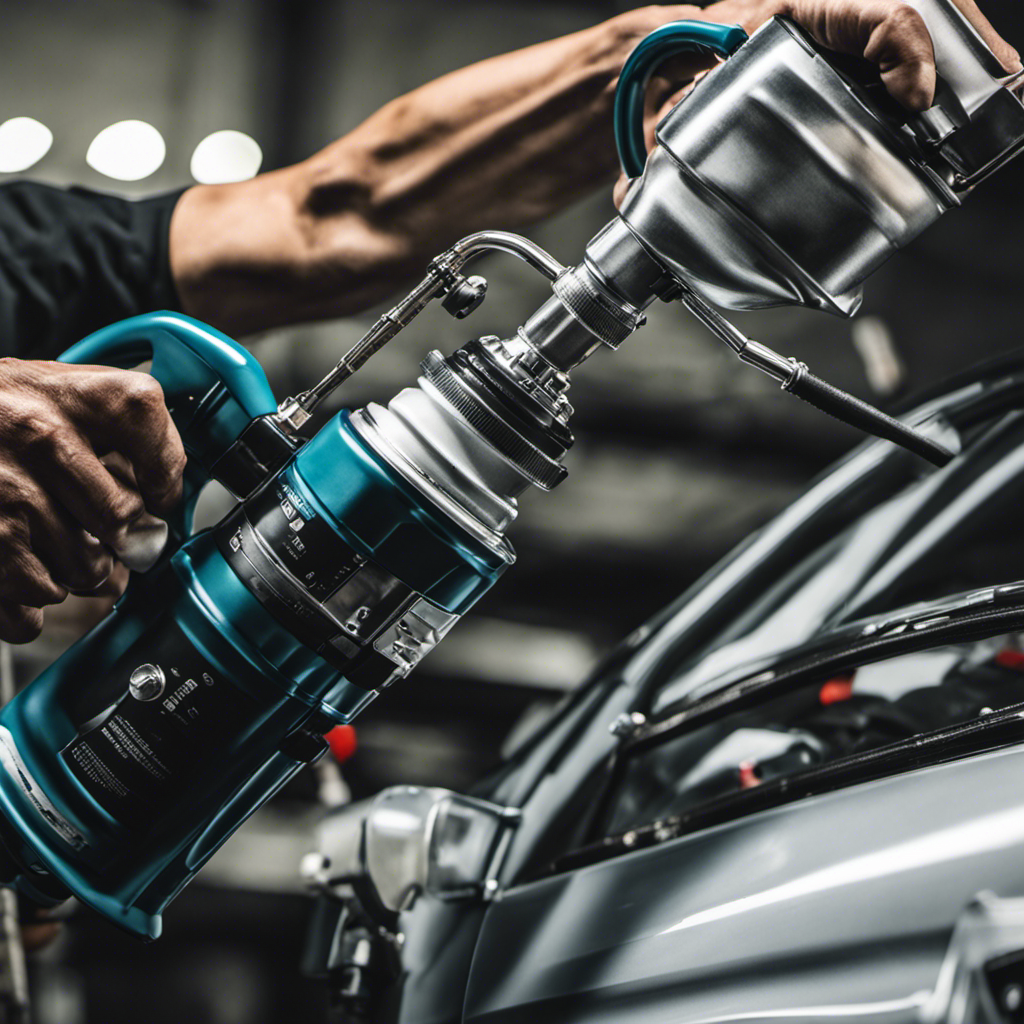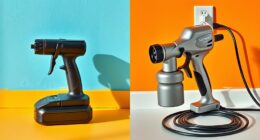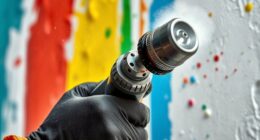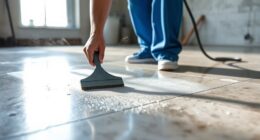When your old paint sprayer shows inconsistent spray patterns, clogging, or leaks, it might be time to repair or replace it. Evaluate repair costs against new models’ prices, considering durability and performance improvements. If repairs are costly or the sprayer is extensively worn, investing in a new unit could save time and effort. To decide confidently, explore the key factors influencing repair versus replacement and discover helpful maintenance tips to extend your sprayer’s life.
Key Takeaways
- Assess the extent of damage and repair costs versus the price of a new sprayer to determine economic feasibility.
- Consider the sprayer’s age, condition, and performance; if outdated or heavily worn, replacement may be more effective.
- Check if repairs restore consistent spray quality and smooth operation; ongoing issues suggest replacement is preferable.
- Evaluate benefits of modern sprayers, such as improved efficiency, easier maintenance, and better spray control.
- Prioritize repairs for minor issues; opt for replacement if major components are damaged or if repairs surpass half the cost of a new unit.
Recognizing Signs Your Paint Sprayer Needs Attention

If your paint sprayer isn’t performing as smoothly as before, it’s a clear sign you need to take a closer look. Over time, the paint sprayer’s durability can decline, leading to inconsistent spray patterns, clogging, or uneven coverage. These issues often indicate internal wear or buildup that hampers performance. Don’t ignore these signs, as they can worsen if left unaddressed. You should consider visiting repair shop options to diagnose and fix the problem early. Repair shops can often restore your sprayer’s functionality without the need for a costly replacement. Recognizing the signs of wear and understanding that maintenance and cleaning might be a feasible option helps extend your equipment’s lifespan and saves money in the long run. Proper cleaning routines and regular inspections can prevent many common issues that lead to decreased performance. Regular maintenance and proper cleaning can also prevent some of these issues and keep your paint sprayer functioning optimally. Additionally, exploring repair options can be a cost-effective way to prolong the life of your sprayer rather than replacing it entirely. Implementing performance upgrades similar to those seen in high-end automotive tuning can sometimes improve efficiency and operation.
Assessing the Cost and Feasibility of Repairs

Before deciding to repair your paint sprayer, you need to contemplate repair cost estimates and whether they fit your budget. Think about the age and durability of the sprayer to determine if repairs are worth it. Also, compare repair costs to the expense of replacing the unit to make an informed choice. Considering the effectiveness of repairs, which can vary based on the condition of the equipment, is essential in this decision-making process. Evaluating the long-term performance of the sprayer after repairs can help determine if a replacement might offer better value. Additionally, assessing whether the sprayer is still within its vetted lifespan can guide your decision on repair versus replacement. Understanding the figurative language techniques used in describing equipment can also deepen your appreciation for maintenance discussions and product descriptions. When evaluating options, consider the cost-benefit analysis to ensure your decision aligns with your project needs and financial constraints.
Repair Cost Estimates
Estimating repair costs for your old paint sprayer involves analyzing the extent of the damage and the parts that need replacement. You should consider whether the repairs will restore ideal paint quality and if they’re covered under warranty. Some repairs, like replacing worn seals or motors, can be affordable, while others, such as replacing the entire pump, may be costly. Use this table to evaluate options:
| Repair Type | Estimated Cost |
|---|---|
| Minor repairs (seals) | $50 – $150 |
| Motor replacement | $200 – $400 |
| Pump replacement | $300 – $600 |
| Warranted repairs | Often covered |
| Total repair estimate | Varies |
Assess whether the investment makes sense or if replacing the sprayer offers better value for maintaining paint quality.
Age and Durability
As your paint sprayer ages, its durability naturally diminishes, making repairs increasingly costly and less reliable. Over time, components wear out, leading to inconsistent paint quality and reduced performance. You might notice that the sprayer struggles with achieving smooth, even coats, impacting your project’s overall finish. Additionally, older models often compromise user comfort, as worn parts can cause vibrations, leaks, or awkward handling. These issues can make extended use tiring and frustrating. When contemplating repairs, evaluate whether investing in fixes will restore the sprayer’s durability and performance or if it’s nearing the end of its useful life. If repairs won’t substantially improve paint quality or user comfort, it may be more practical to consider replacement rather than pouring money into an aging tool. Considering the age and durability of your sprayer can help determine whether repair costs are justified or if upgrading is a smarter choice. Furthermore, understanding the wear and tear process of various parts can help you anticipate future failures and decide if a replacement might be more cost-effective in the long run. Recognizing signs of component failure early can prevent costly breakdowns and ensure consistent project results. Additionally, advancements in automation technology have made modern paint sprayers more efficient and user-friendly, which could be beneficial if replacing your current model. Regular maintenance and awareness of appliance lifespan can also prolong the useful life of your tools and optimize your investment.
Replacement Expenses
Considering repair costs for an aging paint sprayer can help you determine whether fixing it is worthwhile. Replacement expenses vary depending on the paint sprayer brand, parts needed, and whether warranty coverage applies. If repairs are costly or the warranty has expired, buying a new model might be more economical. Imagine this:
- A sleek, modern sprayer ready for heavy-duty projects
- A budget-friendly option that fits your DIY needs
- An older model with rusted components and worn-out nozzles
- A brand with excellent warranty coverage, reducing repair costs
- A high-end model boasting advanced features and durability
Evaluating these factors helps you weigh repair costs against replacement expenses. Sometimes, investing in a new paint sprayer offers better long-term value, especially if repairs are frequent or parts are hard to find. Additionally, regional availability of skilled repair services can influence your decision, making repairs more feasible in some areas than others. Consulting with skilled repair technicians can also provide insight into the true cost and effort required for repairs versus replacement. Remember that rusted components may be difficult or costly to refurbish, further impacting the decision. Furthermore, understanding the product’s durability and performance history can help in making an informed choice. Moreover, being aware of payment processing security measures can ensure your transactions remain protected when purchasing new equipment.
Comparing Features: Old vs. New Models
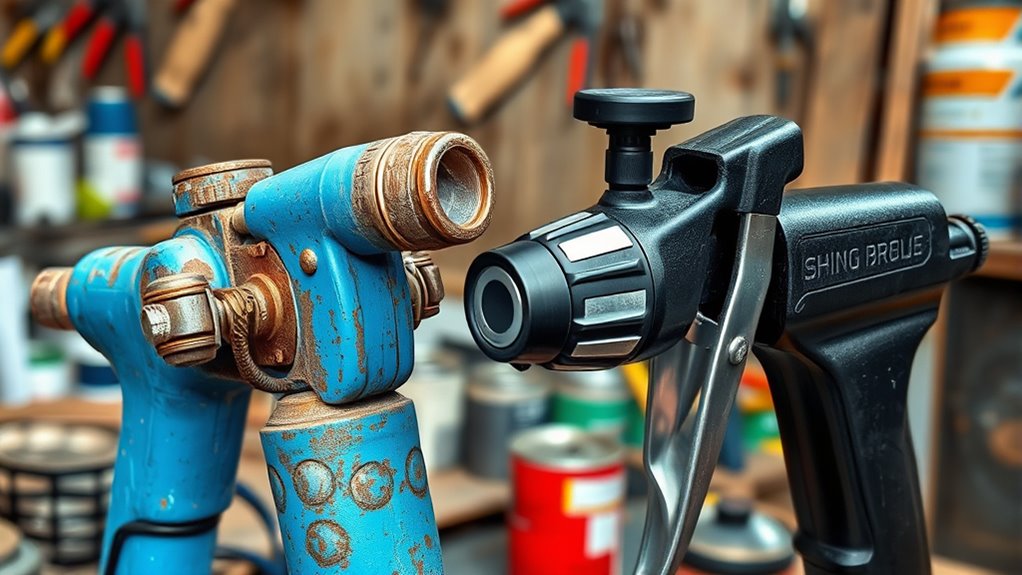
While old paint sprayers can still get the job done, modern models often come with significant improvements in features and performance. You’ll notice better paint quality, thanks to advanced nozzle designs and pressure controls that deliver a smoother, more even finish. Newer sprayers also enhance user experience with ergonomic designs, easier maintenance, and quicker setup times—saving you frustration and effort. Additionally, modern features like adjustable spray patterns and higher efficiency mean you can customize your application for different projects. While older models may be more straightforward, they often lack the precision and convenience found in newer options. Upgrading can provide a more consistent finish and a more comfortable, enjoyable painting process overall. Incorporating toilet efficiency features in your renovation can also lead to water savings, aligning with environmentally conscious choices. Furthermore, choosing the latest paint technology can reduce your overall project time and improve durability. Modern paint sprayers also incorporate energy efficiency features that can lower operational costs over time. Moreover, selecting the right equipment can positively impact your overall project costs and investment returns.
Factors to Consider Before Making a Decision
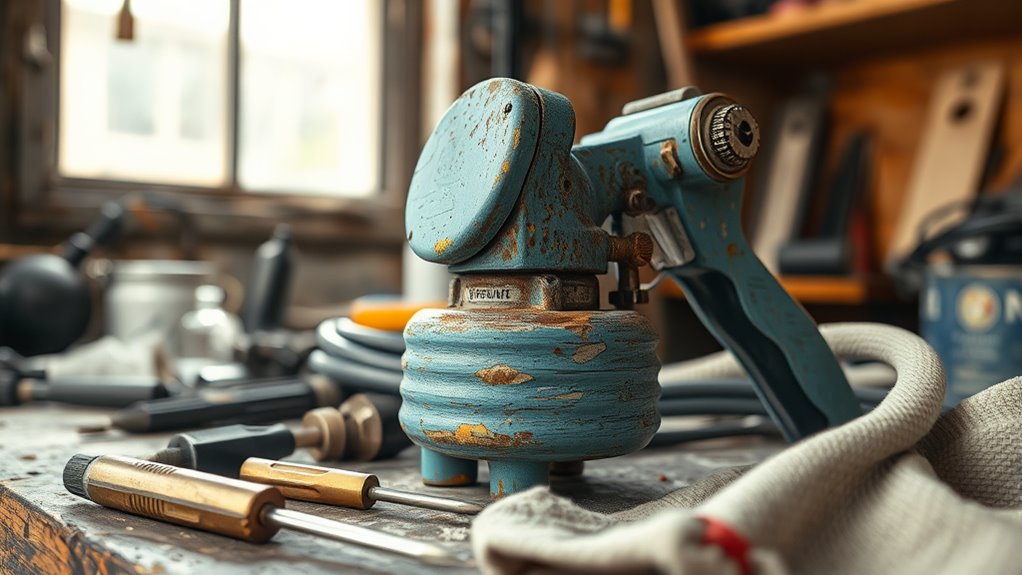
Before deciding whether to revive your old paint sprayer or invest in a new one, you should evaluate several key factors. Consider the paint quality your sprayer can produce—will it deliver smooth, consistent results? Check user reviews to gauge how others have experienced its performance and durability. Think about the sprayer’s age and overall condition—has it had frequent repairs or persistent issues? Assess the cost and effort involved in repairs versus buying new. Finally, reflect on your project needs—does your current equipment meet them? Keep these points in mind: performance consistency and paint finish, reliability based on user reviews, repair costs versus replacement expenses, age and condition of the sprayer, compatibility with your project requirements, and whether the exfoliating properties of glycolic acid can help improve the overall condition of your equipment if applicable. Additionally, understanding industry transformations such as advancements in automation can influence your decision-making process. Furthermore, evaluating the long-term durability of your equipment can ensure sustained performance over time.
Tips for Maintaining and Extending Your Sprayer’s Life
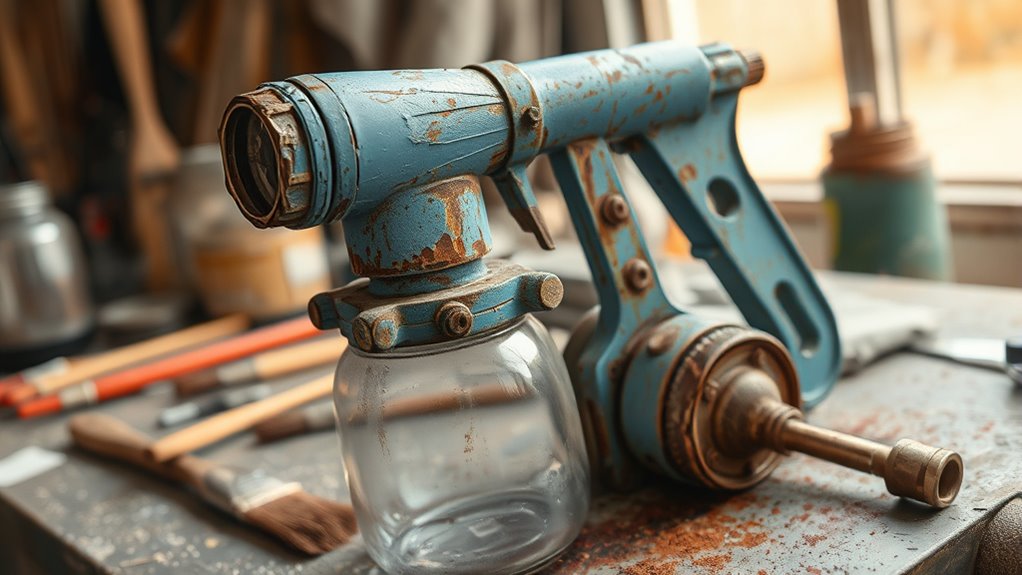
To keep your spray sprayer running smoothly, you need to stay on top of regular cleaning and maintenance. Performing routine checks helps catch issues early and prevents costly repairs down the line. Staying consistent with these practices can greatly extend your sprayer’s lifespan.
Regular Cleaning Practices
Regular cleaning is essential for keeping your paint sprayer in top condition and extending its lifespan. Proper cleaning prevents clogs, preserves spray pattern consistency, and ensures accurate paint color application. After each use, you should flush out residual paint with the appropriate solvent. Pay close attention to the nozzle and filter, removing any buildup that could affect spray quality. Visualize your sprayer with:
- A clear, steady spray pattern resembling a fine mist
- Smooth flow without sputtering or uneven coverage
- No residual paint in the nozzle or hoses
- A clean, unclogged filter with no blockages
- Consistent paint color distribution across surfaces
Routine Maintenance Checks
Performing routine maintenance checks is essential for ensuring your paint sprayer operates smoothly and lasts longer. Regularly inspecting your sprayer helps maintain ideal paint quality by preventing clogs and ensuring even application. Check hoses, filters, and nozzles for wear or damage, replacing parts as needed. Lubricate moving components to reduce friction and avoid breakdowns. Clean the air cap and fluid passages to prevent paint buildup that can compromise spray pattern. These checks also prioritize user safety by reducing the risk of leaks or malfunctions that could cause injury. Consistent maintenance not only extends your sprayer’s lifespan but also guarantees consistent performance, making your painting projects more efficient and professional-looking. Staying proactive with maintenance is key to long-term success.
Making the Final Choice: Repair or Replacement
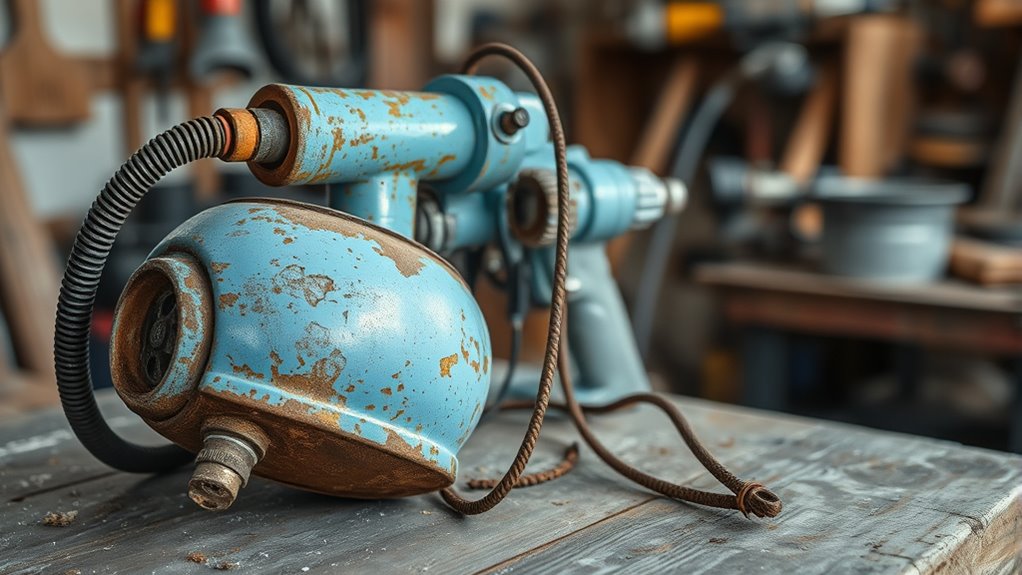
Deciding whether to repair or replace your old paint sprayer depends on several key factors. Consider the overall paint quality and how your user experience is affected. If repairs restore consistent spray patterns, smooth operation, and reliable performance, fixing it makes sense. However, if persistent issues lead to uneven coverage or frustration, replacement might be best. Visualize:
- A sprayer delivering a flawless, even coat
- Smooth operation with minimal effort
- Quiet, vibration-free use
- Consistent spray patterns
- Reduced cleanup time
If these benefits seem out of reach after repairs, investing in a new model could save you time and hassle. Balancing repair costs against the value of improved paint quality and user comfort will guide your final decision.
Frequently Asked Questions
How Long Should a Paint Sprayer Typically Last Before Needing Replacement?
A paint sprayer’s lifespan varies based on usage and maintenance, but generally, you can expect about 3-5 years of reliable service. When considering replacement, think about how often it breaks down or requires repairs. If repairs become frequent or cost more than a new unit, replacement is a smart choice. Ultimately, weighing the sprayer’s age against its performance helps determine if it’s time to upgrade or repair.
Are There Specific Brands Known for More Durable Old Paint Sprayer Models?
You might think all vintage models are fragile relics, but some brands prove otherwise. When considering brand durability, look at older Wagner or Graco models—they often outlast newer, flashier counterparts. These brands built vintage models tough, making them surprisingly reliable. So, if you find a well-maintained vintage sprayer from these brands, it might just be more durable than you’d expect, saving you money and frustration in the long run.
What Are Hidden Costs Involved in Repairing an Outdated Paint Sprayer?
When considering repairing an old paint sprayer, you should be aware of hidden costs that can add up quickly. Repair expenses might include replacement parts, labor, and potential upgrades to guarantee ideal performance. These hidden costs could surpass the price of a new model, making repair less economical. It’s crucial to weigh these factors carefully to decide whether repair costs justify fixing your outdated sprayer or if replacing it is a smarter choice.
Can DIY Repairs Extend the Lifespan of My Paint Sprayer Effectively?
Think of your paint sprayer like a vintage car—you can keep it running with proper maintenance tips. DIY troubleshooting can indeed extend its lifespan if you’re handy and cautious. Regular cleaning, checking seals, and replacing worn parts can prevent major issues. However, beware of overestimating your skills; sometimes, professional repairs save time and money. Proper care can keep your sprayer humming longer, but know when to call in a pro.
How Does the Environmental Impact Compare Between Repairing and Replacing?
When deciding whether to repair or replace your paint sprayer, consider the environmental impact. Repairing your sprayer generally leads to better disposal practices and encourages material recycling, reducing waste. Replacing it might result in more electronic waste and increased resource consumption. By repairing, you extend its life, minimize environmental harm, and support sustainable practices. So, if repairs are feasible, they’re usually the greener choice for your sprayer’s future.
Conclusion
Ultimately, whether you repair or replace your paint sprayer, envision it as a trusty tool ready to paint fresh strokes on your project’s canvas. Imagine the smooth spray of a renewed machine or the promise of a new model gleaming with potential. By weighing its current condition against your needs, you’ll make a choice that keeps your creative vision flowing effortlessly, transforming dull surfaces into vibrant masterpieces.
A seasoned painter with over 15 years in the industry, Mike transitioned from hands-on painting projects to the digital world of paint sprayers. His extensive experience gives him a unique perspective on what users truly need when it comes to painting tools. As the Editor in Chief of Paint Sprayer Zone, Mike ensures that every piece of content not only provides value but also reflects the realities of painting — the challenges, the joys, and the intricate details.



